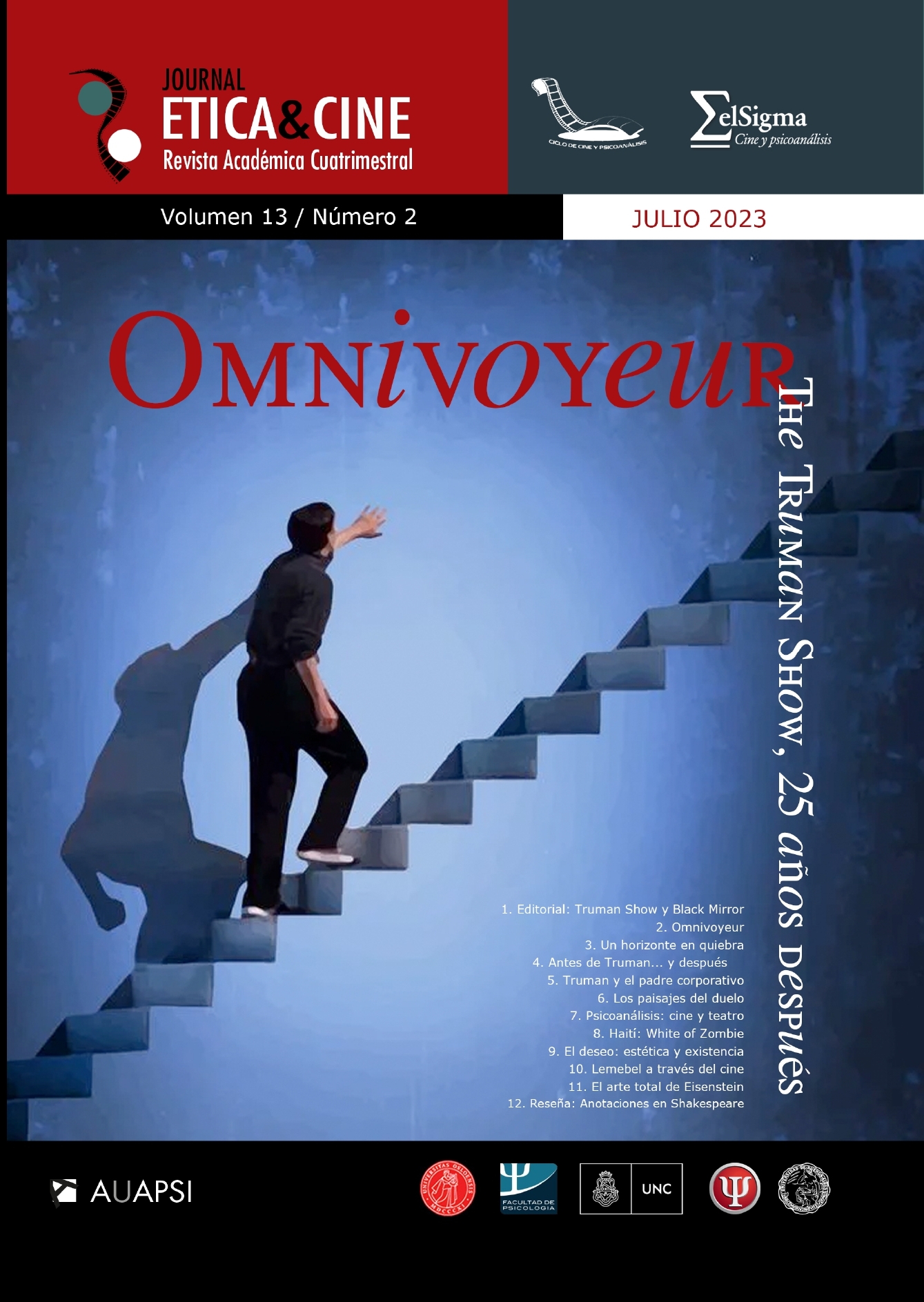The Total Art of Eisenstein: The Ideology Behind The old and the New
DOI:
https://doi.org/10.31056/2250.5415.v13.n2.41974Keywords:
Soviet Union, Sergei Eisenstein, Cinema, Ideology, StalinismAbstract
The history behind early Soviet cinema has fascinated Western scholars for decades. Conflicting accounts of unpublished scripts and censorship by the Communist Party have prompted detailed discussions on the limits imposed by the young Stalinist regime over the members of cultural vanguards. However, these debates occlude the larger problem of how the works produced by artists such as Sergei Eisenstein expressed the ideological tensions of a social system that was struggling to find a fitting balance between democracy and authority, between experimentation and order. Our study analyzes the 1929 film The old and the new, with the aim of exploring how these same tensions could manifest themselves well beyond the apparently opposed interests of art and politics. With this objective, we make use of the Lacanian theory of the unconscious, which allows us to analyze the duality of behaviors that can be manifested from within a single discursive subject.
References
Referencias bibliográficas
Bordwell, D. (1999). El cine de Eisenstein. Teoría y práctica. Paidós, 1999.
Briley, R. (1996). “Sergei Eisenstein: The Artist in Service of the Revolution”. The History Teacher, Vol. 29, nº 4, pp. 525–536.
Burns, P. E. (1981). “Cultural Revolution, Collectivization, and Soviet Cinema: Eisenstein’s Old and New and Dovzhenko’s Earth”. Film & History: An Interdisciplinary Journal of Film and Television Studies, Vol. 11, nº 4, pp. 84-96.
David-Fox, M. (2012). “The Potemkin Village Dilemma”. Showcasing the Great Experiment: Cultural Diplomacy and Western Visitors to the Soviet Union, 1921–1941. Oxford University Press.
Ferro, M. (2000). Historia contemporánea y cine. Ariel.
Fontana, P. (2012). Cine y colectivización. La representación cinematográfica del proceso de colectivización soviético. Zeit.
Fontana, P. (2016). “Cine y colectivización. Imágenes para un orden nuevo en los campos soviéticos (1929-1941)”. Políticas de la Memoria, nº 16, pp. 245-252.
Goffman, E. (2006). Frame Analysis, Los marcos de la experiencia. Siglo XXI.
Goodwin, J. (1993). Eisenstein, Cinema, and History, University of Illinois Press.
Groys, B. (1992). The Total Art of Stalinism, avant-garde, aesthetic dictatorship, and beyond. Princeton University Press.
Hjort, M. (2005). Cinema and Nation. Routledge.
Kagarlitsky, B. (2006). Los intelectuales y el Estado soviético. De 1917 al presente. Prometeo.
Kepley, V. (1974). “The Evolution of Eisenstein’s ‘Old and New’”. Cinema Journal, Vol. 14 nº 1, pp. 34-50.
Sánchez Noriega, J. L. (2002). Historia del cine. Teoría y géneros cinematográficos, fotografía y televisión. Alianza.
Lacan, J. (1994). La relación del objeto. Seminario 4. Paidós.
Lacan, J. (1999). Las formaciones del inconsciente. Seminario 5. Paidós.
Lacan, J. (2008). La transferencia: Seminario 8. Paidós.
Laclau, E. (2003). “Prefacio” en Žižek S. El sublime objeto de la ideología. Siglo XXI.
Lefebvre, H. (1969). Sociología de Marx. Península.
Lewin, M. (2005). The soviet century. Verso.
Narboni, J. (1976). “Le hors-cadre decide de tout”. Cahiers du Cinema, nº 271, pp. 14-2.
Persing, W. (2015). "The Ecstasy of Economics: the Evolution of Sergei Eisenstein’s the Old and the New”, Honors Theses, vol. 304.
Pirani, S. (2010). La revolución rusa en retirada, 1920-1924. Los trabajadores soviéticos y la nueva elite comunista, Serie “Estudios Rusos”, N° 7, Fichas de Cátedra, OPFyL.
Vidal, S. R. (2022). Sergei Eisenstein y el Cine de Propaganda: La técnica para el nuevo mundo soviético (1925-1929), Universidad de Concepción.
Service, R. (2000). Historia de Rusia en el siglo XX. Crítica.
Tertz, A. (1960). On Socialist Realism. Pantheon Books.
Viola, L. (1996). Peasant Rebels Under Stalin: Collectivization and the Culture of Peasant Resistance. Oxford University Press.
Žižek, S. (2002). Mirando el sesgo: una introducción a Jacques Lacan a través de la cultura popular. Paidós.
Žižek, S. (2003). El sublime objeto de la ideología. Siglo XXI.
Žižek, S. (2008). Cómo leer a Lacan. Paidós.
Referencias filmográficas
Eisenstein, S. (Director). (1925). La huelga [Film]. URSS.
Eisenstein, S. (Director). (1929). Lo viejo y lo nuevo [Film]. URSS.
Chujrai, G. (Director). (1961). Cielo despejado [Film]. URSS.
Downloads
Published
Issue
Section
License
Copyright (c) 2023 Ética y Cine Journal

This work is licensed under a Creative Commons Attribution-ShareAlike 4.0 International License.
Los autores que publiquen en Ética y Cine Journal aceptan las siguientes condiciones:
Los autores/as conservan los derechos de autor © y permiten la publicación a Ética y Cine Journal, bajo licencia CC BY-SA / Reconocimiento - Reconocimiento-CompartirIgual 4.0 Internacional. La adopción de esta licencia permite copiar, redistribuir, comunicar públicamente la obra, reconociendo los créditos de la misma, y construir sobre el material publicado, debiendo otorgar el crédito apropiado a través de un enlace a la licencia e indicando si se realizaron cambios.

Este obra está bajo una licencia de Creative Commons Reconocimiento-CompartirIgual 4.0 Internacional.




